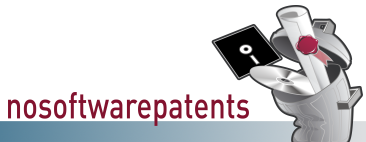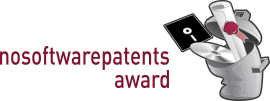| English | Deutsch |

![- Logo]](../images/layout007-small.png)
| Home |
| Software Patent of the year 2006 |
| About |
| Supporters |
| Background |
| News |
| Press November |
| Links |
| Contact |
| Imprint |
July – Patent 4
- EU-Patent on software (algorithm)
- Application to European Patent Office on 25/6/1996 by Siemens AG (Germany)
- Granted on 14/1/2004
- Date of priority: 6/7/1995 (valid no more than until 6.7.2015)
- Patent attorney: —
- Appeal filed on 13/10/2004 by SAGEM S.A. (France) on grounds of lacking patentability according to articles 52 to 57 EPC, on grounds of incompleteness, lacking perspicuity of the patent specification and undue width of patent claims
- Appeal withdrawn on 19/12/2005
- Patent specification provided by FFII/Gauss
- Patent specification provided by EPO/espacene
- Access to records provided by EPO/epoline
- The decisive element are the claims, as they specify which actions are forbidden within the framework of the patent.
- Violating one single claim is sufficient to be considered a patent violation. Generally, claim number 1 is the decisive main claim which covers all other claims relating to special cases.
- The description is intended to help the reader interpret the claim. At the same time, it is supposed to document and disclose the details of the invention. This disclosure is the original purpose of the entire patent system.
- In practice, a patent specification contains no detailed information on how the patented procedure could be implemented (even if the patent owner allowed the implementation). In particular, a software patent contains no program code (reference implementation), but merely describes the idea of a software.
Patented idea: Data exchange via cellular network
Main claim: Exchange of data packets between a mobile client and a server via a cellular network
Further claims:
- Identification of members and/or network, authentification, encryption, etc.
- Sending first the header then the data
- Server static or mobile
- Authentification of the client toward the server
- Bidirectional data exchange
Description: The patent specification documents that it is possible to exchange data between a mobile phone and a server. The main features of standard network protocols are outlined by including creative terms and expressions while conventional computer terms are avoided. In contrast to this the concepts of mobile technology are defined with conventional terms and abbreviations (e.g. "GSM" for "Global System for Mobile Communication"). Consequently the patent specification alludes more to mobile radio than to computer networks.
Everyday parallel: Yet in antiquity it was usual that travellers "mobile clients") took carrier pigeons ("cellular network") with them. A carrier pigeon can transport a slip of paper fixed to the bird's leg "data packet") by an average speed of 100 km/h. According to this principle even bidirectional internet connections have been realised – see RfC 1149 and the implementation by LUG Bergen (Norway).
Examples for patent infringement:
- Using a cellular phone as a modem
- SMS, MMS
- WLAN
| Previous Software Patents of the Month |
| > September |
| > August |
| > July |
| Patent 1 | |
| Patent 2 | |
| Patent 3 | |
| Patent 4 | |
| Patent 5 |
| > June |
| > May |
| > April |
| > March |
| Press Archive |
| > Oktober |
| > September |
| > August |
| > July |
| > June |
| > May |
| > April |
| > March |
